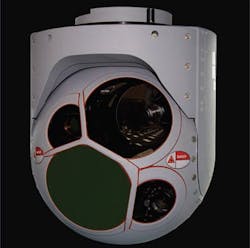Navy chooses digital HD electro-optical sensors from L-3 Wescam for P-8A Poseidon jet
LAKEHURST, N.J., 29 June 2015. U.S. Navy maritime surveillance experts needed high-altitude surveillance electro-optical sensors for the Navy Boeing P-8A Poseidon maritime patrol aircraft. They found their solution from L-3 Wescam in Burlington, Ontario.
Officials of the Naval Air Warfare Center Aircraft Division in Lakehurst, N.J., announced plans Thursday to purchase the company's MX-20HD digital high-definition electro optical/infrared (EO/IR) systems, technical data, and repair services for integrating the sensors aboard the P-8A aircraft.
The L-3 Wescam MX-20HD electro-optical sensor system is for intelligence, surveillance, and reconnaissance (ISR) capability aboard high-altitude long-range maritime patrol aircraft and persistent surveillance missions.
The pod-mounted sensor suite is suitable for fixed-wing aircraft, helicopters, unmanned aerial vehicles (UAVs), and aerostats, company officials say.
L-3 Wescam is the sole designer, developer, and manufacturer of the MX-20HD EO/IR system for use in the P-8A, and is the only source that is able to supply a system capable of meeting the P-8A requirements, Navy officials say. The government does not own the system's technical data and drawings.
The MX-20HD EO/IR system has multi-sensor imaging and lasing payload options, and can support as many as seven sensors simultaneously for HD imaging from visible-light and infrared cameras. It also has three laser illuminator options.
The system offers real-time image enhance for daytime, nighttime, and infrared operations, and its inertial sensors work together to create accurate target location, automatic alignment to the aircraft, and automatic image focus.
The sensor pod offers five-axis gimbal stabilization with an internal inertial measurement unit.
Although Navy officials are not specifically inviting competitive bids, they say they will consider responses from other companies to the Navy's Alicia McPeters, who can be reached by email at [email protected], or by phone at 732-323-5368.
More information is online at https://www.fbo.gov/spg/DON/NAVAIR/N68335/N68335-15-RFI-0212/listing.html.
For additional information contact L-3 Wescam online at www.wescam.com, or the Naval Air Warfare Center Aircraft Division-Lakehurst at www.navair.navy.mil.

John Keller | Editor
John Keller is editor-in-chief of Military & Aerospace Electronics magazine, which provides extensive coverage and analysis of enabling electronic and optoelectronic technologies in military, space, and commercial aviation applications. A member of the Military & Aerospace Electronics staff since the magazine's founding in 1989, Mr. Keller took over as chief editor in 1995.

